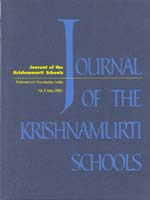Issue 5 - May 2001

- Written by J. Krishnamurti
High in the mountains there were hardly any birds; there were some crows, there were deer and an occasional bear.
- Written by Editorial Team
There is a churning in the world of education. Teachers, parents, administrators and policy-makers are being driven to question anew: ‘What are we doing with our children?’ ‘What values, dispositions and concerns are we creating in them?’ ‘What is the quality of relationships with peers and others that our children are imbibing?’ ‘What will be their relationship with the society and environment they are part of?’ ‘Will future generations be able to find wholesome responses to the many complex challenges of their times?’ These questions are not speculative or academic, but stem from sensitive observation of everyday realities, as much in the classroom as in the society around us.
- Written by Shailesh Shirali
I wonder what the future holds for us in the Krishnamurti schools.
- Written by Stephen Smith
Consciousness is the primary datum of existence, of human existence, and perhaps of all existence.
- Written by Suchitra Ramkumar
The work of the Kindergarten teacher involves many dimensions of understanding.
- Written by Shobha Gopalan and Anya van Z. Langhout
Working with the intentions of the Krishnamurti schools takes us deep into the question, ‘What is learning?’ We can explore this better when we do not divide or compartmentalize learning into academic and non-academic, and separate this from day-to-day living.
- Written by Patrick Foster
One of the units of my 10th grade English class at Oak Grove School is ‘critical thinking.’
- Written by Lorenzo Castellari
‘Hey! I thought you said you had vertigo!?’
- Written by Kabir Jaithirtha
In educating children, apart from developing their physical, intellectual and aesthetic capacities, are we not concerned with a non-verbal movement of the mind, with a heightened quality of attention, of observation and listening?
- Written by G. Gautama
To a thinking person, it is quite clear that human beings have collectively contributed more problems to the earth than any other species.
- Written by Editors
Brockwood Park School in England, founded by Krishnamurti in 1969, is an international residential school that brings together around 60 students from around 20 countries, aged between 14 and 20.
- Written by Bill Taylor
Like the first page of a novel, the first scene of a play, or the first chords of a piece of music, the first week of a new school year must communicate a lot.
- Written by Toon Zweers
Introduction In this piece I will discuss an Anthropology module we did at Brockwood, as part of a new class called the ‘Main Lesson’.
- Written by Steffi Barna
Last year Brockwood Park School initiated a new art class to explore the expressions of Western contemporary art, focusing on the phenomenon of ‘Conceptual Art’.
- Written by Editors
The information revolution is sweeping the world. Computer networks capable of storing, processing and transmitting vast amounts of data are webbing their way into the lives of people the world over.
- Written by S. Gopalan
For me, the central questions raised by the advent of computers in education are: How does the arrival of computers affect the teacher and what implications does this have for his role?
- Written by S. Jayaram
Living and teaching in a school situated in the hub of the IT revolution, the impact of computers on a child’s psyche is not hard to observe.
- Written by A. Kumaraswamy
There has been a great deal of discussion regarding the use of computers and Internet in school education, more specifically in the area of teaching/ learning processes.
- Written by R. E. Mark Lee
Information technology is changing and morphing so dramatically – Gordon Moore’s now-famous law projects the doubling of computer power every 18 months – that its implications for education can hardly be viewed from any fixed point.
- Written by O. R. Rao
Sherlock Holmes, as is well known, was a person who was subject to violent fluctuations of mood.
- Written by Kartik Kalyanram
Images of GeographyGeography – the very name conjures up images of misty mountains, bubbling brooks, rapidly flowing rills, deep gorges, endless undulating plains, and majestic rivers, so slow-flowing that they almost seem indolent, yet with a hidden power that man has sought to harness for aeons.
- Written by Chandrika Mathur
A few years ago I made a transition from teaching French as a foreign language to adults to making materials for teaching Hindi as a second language to young school goers in South India.
- Written by Anurag Jain
Going back through my diary and taking out excerpts for the Journal has been a rewarding experience for me.
- Written by Sudha Premnath
The Kaigal Valley landThe Krishnamurti Foundation India has had in its care about 200 acres of beautiful forest land at Kaigal Valley near the town of Palamner since 1984.
- Written by V. Shantaram
There was a slight movement on the branch above us, well over fifty feet high.
- Written by Revathi Sreenivas
I undertook training in Kindergarten education at the Children’s Garden School in Chennai in 1978.
- Written by Shashidhar Jagadeeshan
I am sure all you mathematics teachers out there have had the following experience.
- Written by Suchitra Ramkumar
This is a set of six videos on child development, each lasting from one to one and a half hours, anchored by Dr. Joseph Chilton Pearce, a well-known author and psychologist.
- Written by Akhila Seshadri
It is rarely that one comes across a book about young girls that is not merely a saga of their times, of the pain and struggles in their lives, but also takes a proactive approach to actually doing what the title suggests – Reviving Ophelia.

